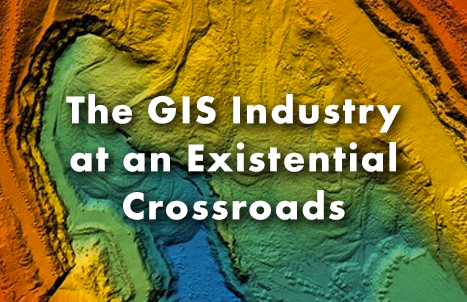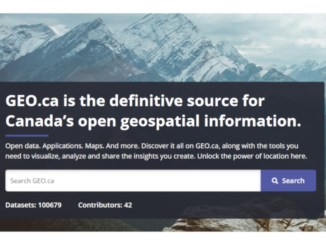
The Geographic Information Systems (GIS) industry has experienced numerous pivotal moments throughout its evolution. Each technological advancement—from the early days of workstations to the widespread adoption of desktop GIS, the integration of enterprise GIS, and the proliferation of web GIS—has marked significant shifts in how geospatial data is processed, analyzed, and utilized. Yet, today’s crossroads present a fundamentally different and more profound challenge. This time, the change is not merely driven by technological innovation; it is about redefining the very essence of who we are and what we do as GIS professionals.
The Historical Crossroads
There are a few articles that explore the various eras in GIS technology and the industry’s evolution. Tellingly, they tend to focus on technological drivers of change. Of note are online articles from BCS, GIS Geography, and Esri. Broadly, the historical development of GIS can be synthesized into five technology-driven eras.
Workstation Era
The inception of GIS can be traced back to powerful workstations that allowed for the first digital handling of geographic data. This period was characterized by high costs and limited access, making GIS a specialized field within government and large organizations. GIS professionals of this era were pioneers, developing foundational techniques and establishing the initial value proposition of geospatial analysis.
Desktop Era
The advent of desktop GIS democratized access to geospatial tools. Software like ArcView and MapInfo brought GIS capabilities to personal computers, significantly broadening the user base. This era marked a transition from a highly specialized field to a more accessible and widely applicable discipline. GIS professionals adapted by focusing on developing applications, customizing solutions, and educating a broader audience about the potential of GIS.
Enterprise GIS Era
The next significant shift was the integration of GIS into enterprise systems. GIS became a core component of business intelligence, supporting decision-making processes across various industries. This period saw GIS professionals collaborating closely with IT departments, integrating geospatial data into relational database management systems and connecting with other enterprise data systems – emphasizing the scalability and interoperability of GIS solutions.
Web GIS Era
The emergence of web GIS revolutionized how geospatial data is shared and consumed. Platforms like ArcGIS Online and Google Maps made GIS data and tools accessible to anyone with an internet connection. This shift not only broadened the audience further but also transformed GIS into a collaborative and interactive platform. GIS professionals had to adapt to new skills, including web development, and focus on creating user-friendly, web-based applications.
The Current Era
When looking at the literature today, it appears the pattern of focusing exclusively on technology drivers of change is continuing. There are – unsurprisingly – many articles that focus on the technological innovations one can choose from when trying to articulate the next big thing in GIS such as VGIS, MGISS, and Esri. An article from Lepton Software does provide a very good (albeit high-level) attempt to connect the dots of current technology innovations with practical examples. The list of current technology drivers is long:
- Cloud-Based GIS Solutions
- Integration with IoT and Sensor Networks
- 3D Mapping and Digital Twins
- Artificial Intelligence and Machine Learning
- Augmented Reality (AR) and Geospatial Applications
- Real-Time Data and Big Data Analysis
The list goes on.
The Existential Crossroads: Beyond Technology
Missing from most of the current literature on the road ahead for GIS is any sort of meaningful examination of perspective of where GIS professionals should go that is not strictly a technology innovation. There is some – such as GIM International – but generally most of the work being done on the technological evolution and its impact on organizations is being done outside the GIS Industry, such as MDPI and UNESCO.
Going beyond technology, the crossroads the GIS industry is faced with today is far more existential. The challenge before us is not about adapting to a new technological paradigm but re-examining the very essence of GIS and the role of GIS professionals. Several factors contribute to this existential shift:
Data Explosion and the Democratization of Data Science
The explosion of data, coupled with advancements in data science and machine learning, is reshaping the landscape. Massive amounts of geospatial data are generated daily from satellites, drones, IoT devices, and social media. Simultaneously, the rise of data science as a discipline has introduced new methodologies and tools for data analysis. GIS professionals must now integrate these advanced analytical techniques into their workflows. The question is not just how to handle more data, but how to derive meaningful insights and actionable intelligence from it.
Interdisciplinary Integration
GIS is increasingly intersecting with other fields such as urban planning, environmental science, public health, and social sciences. This interdisciplinary approach requires GIS professionals to develop a broader understanding of these fields and collaborate more closely with experts from diverse domains. The traditional role of a GIS specialist as a technical expert is evolving into that of a facilitator and integrator of geospatial knowledge across disciplines.
Ethical and Social Implications
As GIS technology becomes more pervasive, the ethical implications of its use become more pronounced. Issues related to privacy, data security, and the potential for bias in spatial analysis are gaining attention. GIS professionals must navigate these ethical challenges, ensuring that their work promotes equity and social good. This responsibility requires a heightened awareness of the societal impact of geospatial technologies and a commitment to ethical principles.
Redefining Professional Identity
At this existential crossroads, GIS professionals need to redefine their identity. This involves moving beyond technical proficiency to embrace roles as thought leaders, advocates for ethical use of geospatial data, and innovators who drive positive social change. It’s about recognizing the power of geospatial information to address global challenges such as climate change, urbanization, and public health crises.
Embracing the Future
To navigate this existential crossroads, GIS professionals must adopt a mindset of continuous learning and adaptability. Here are some strategies to consider:
1. Embrace Interdisciplinary Collaboration
Engage with professionals from other fields, participate in interdisciplinary projects, and seek to understand how geospatial data can enhance various domains. This will not only broaden your expertise but also highlight the integral role of GIS in addressing complex global issues.
2. Focus on Impacts
Go beyond merely developing technical proficiency in data science techniques and tools such as Big Data, Analysis and AI. Seek an understanding of how these technologies, when combined with geospatial data, can have a positive impact on organizations.
3. Commit to Ethical Practices
Stay informed about the ethical implications of geospatial technologies. Advocate for transparency, privacy, and inclusivity in your work. Develop and adhere to ethical guidelines that ensure your contributions promote social good.
4. Promote the Value of GIS
Communicate the value of geospatial information to a broader audience. Use storytelling and visualization to make complex data accessible and engaging. Highlight the impact of GIS on real-world problems and advocate for its role in policy and decision-making.
The GIS industry stands at a profound juncture, where the future is shaped not just by technological advancements but by the collective vision and ethical commitment of its professionals. As we redefine our identity and embrace new roles, we can lead the way in creating a more informed, equitable, and sustainable world.





Be the first to comment